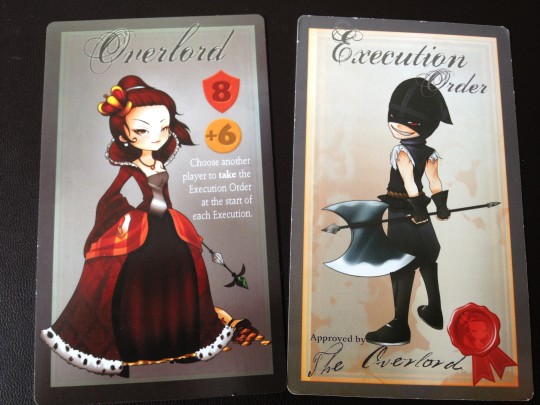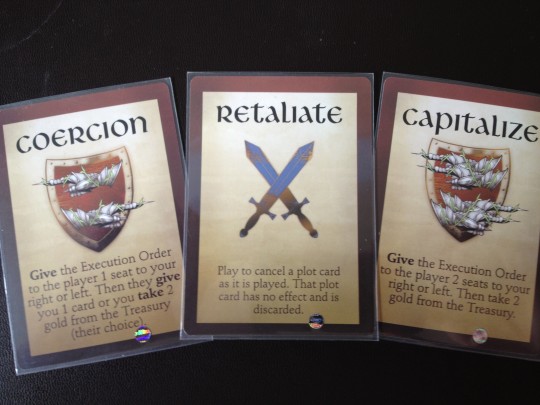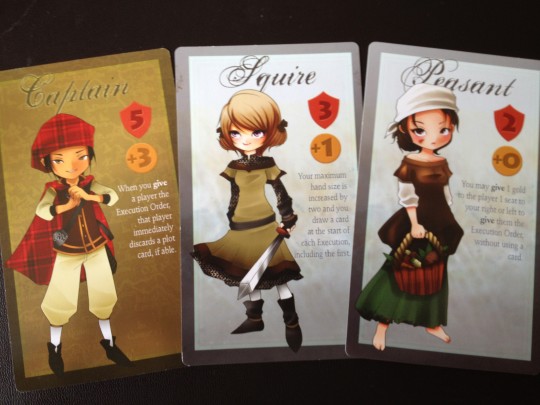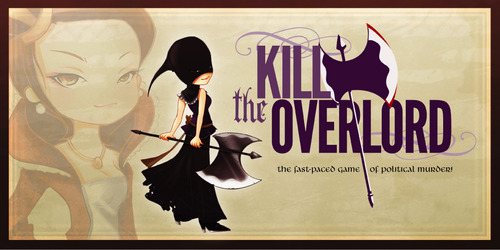Think fast and don’t lose your head! A review of Kill the Overlord.
Title: Kill the Overlord
Year Published: 2012
Designer: D Brad Talton Jr
Publisher: APE Games
Players: 4-8
Game Time: 45 Mins
Set-up Time: >5 Mins
Ages: 8+
Theme: Medieval Politics
Mechanic: Hand Management, Take That
How to win: Win a round as the Overlord or, as the Overlord, have 30 Gold
Game Description
It’s good to be the Overlord. You have minions to grovel at your feet, limitless wealth, and absolute power over all the lands – but you know that your subjects are plotting. They envy your wealth and hope to steal it for themselves, specifically by removing you from the picture.
So you’ve decided to secure your power and eliminate these individuals by sending your executioner out with orders to kill the first person he meets. Unfortunately, your executioner is a gullible fellow who’s extremely enthusiastic about his job – easy to dissuade and misdirect, if you’re clever enough.
Who will be the first player with no excuse to miss his own funeral? Once the axe starts swinging, not even the Overlord is safe!
Kill the Overlord Set Up
Take the roles needed for the number of players, shuffle and deal. Each player also receives 5 Gold and two random Plot cards.
Kill the Overlord Game Play
Kill the Overlord is simple. The player who was randomly assigned the Overlord also gets the Execution order. He then chooses someone on the table to receive it. (He doesn’t GIVE it to someone they receive it, more on that distinction later.)
The player with the Execution order then uses their character ability or plot cards to move the execution order to another player.
This continues until the person with the Execution order cannot get rid of it. When this happens they are eliminated this round, they take the lowest Elimination token, put their Character card into the middle of the table and the Execution order is returned to the Overlord.

The Overlord chooses someone to take the order, lather, rinse, repeat. This continues until either Overlord is the last player remaining, in which case they win the entire game, or the Overlord is executed, in which case the Execution phase ends.
Game Phases
If the Overlord was Executed roles change around the table. I’ll explain this more now as I go through each stage of a turn.
1 – Draw – Each player draws up to 2 cards. The hand limit is 4, your character can change this.
2 – Income – Each player takes (or gives away) gold equal to the income stated on their Character card.
3 – Coronation – In this phase you simply check to see if the current Overlord has 30 or more Gold, if they do, they win the game.
4 – Executions – This is where the Execution order is passed around the table as explained earlier. This phase ends when either the Overlord is Executed or the Overlord is the last player left, in which case they win the game.
5 – Change Roles – This is where players change roles, this phase is divided into 3…
Each character has a rank 1-8 (8 being the Overlord). In this part of the Change Roles phase, players that were not executed increase rank in order. The highest-ranked surviving player will become the new Overlord.
Each other surviving player follows in decreasing order putting their old Character card into the middle of the table and taking the highest rank card available.
Then players that were eliminated take the roles remaining in the middle of the table starting with the player with the lowest number. This will mean the previous Overlord will now be the lowest rank.
Oh, how the mighty fall!
6 – Shuffle – All used plot cards are shuffled into the deck.
It’s a game of Giving and Taking. I mentioned earlier the Overlord chooses someone to take it and doesn’t Give it to someone. This is because certain plot cards react when the Execution order is Given to you.
Plot Cards
How to use these plot cards is key to winning the game. Once you run out of cards you’re ripe for Execution so you need to make sure you use cards wisely. You also need to make sure a player isn’t building up too many cards in their hand. You draw 2 each turn and the hand limit is 4. A player with 4 cards will have more options than a player with 2 cards and be a touch more powerful.

So you need to team up against the current Overlord while also making sure a player doesn’t end the Execution phase with too many cards. This is a very tactical part of the game.
Also, plot cards are restrictive, it will say where you can possibly give the execution order to, you can’t just give it to anyone. It will say things like either 1 or 2 seats to your left or 2 places to your right etc

Roles
Of course, plot cards are good but the Character cards make the game. These are the roles for the basic game.
Rank 1 – Servant
The Servant gives 1 Gold to the Overlord in the Income phase but if someone with more cards than the Servant gives them the Execution order, they draw a card. Powerful.
Rank 2 – Peasant
No income, but you may pay 1 gold to the player to your left or right to Give them the Execution order. Surviving as the Peasant is quite easy so ranking up fast is very possible.
Rank 3 – Squire
1 Gold in the income phase but your hand size is increased by 2 AND you draw a card at the start of EACH Execution, including the first. Cards = Options = Survival.
Rank 4 – Knight
2 Gold for income but players can not take, or make you discard Gold or Plot cards.
Rank 5 – Captain
3 Gold in the income phase and when you Give the execution order to a player they discard a card. Very powerful!
Rank 6 – General
4 income, and can give the execution order to any player instead of where the plot card tells you to.
Rank 7 – Advisor
5 income and is not affected by the Powerful book type Plot cards.
Rank 8 – Overlord
6 income, and chooses a player to take the Execution order at the start of each Execution.
There are 2 other sets of Characters that are a bit more ‘Party Game’. (Closing eyes, cards on head etc)
Kill the Overlord End Game
Either, the Overlord is the last person standing at the end of the Execution phase or at the Coronation phase, the player who is the Overlord has 30 Gold.
Kill the Overlord Round-Up
I’ve never played this game where people were not having fun. That’s a fact.
But I have two issues.
1 – The game starts s…l…o…w. You start with 5 gold, at the start of the second round, the Overlord will have 12 (Starting 5 + 6 income + 1 from the Servant). At the third round, the Overlord will have 11. If you start as the Captain by the 3rd round you’ll have around 14, and probably be in the lead.
This is fine… but the game starts to get REALLY good when several players are on 20-24+ Gold and have a chance of winning the game in the next couple of rounds.
The first 5-6 rounds feel NOTHING like the last 2-3 which is a real shame.
2 – It’s a little random. It seems to be a case of the winner ‘just so happens’ to be the Overlord next. It’s very VERY hard to manipulate the order to make sure you’re in the Overlord’s hot seat the turn you get 30 gold. It’s possible, but only just.
Rating
Although it starts slow it IS fun and that’s all you can ask for it a game. It’s better with 7-8 players but still one I couldn’t keep in my collection.
I give this 4/10


Leave a Reply